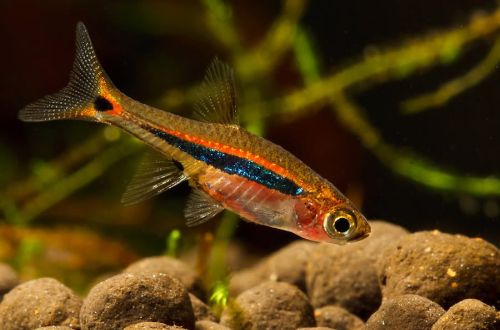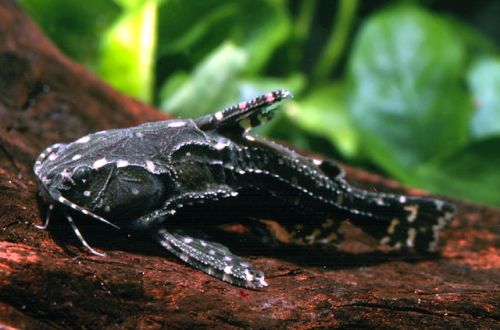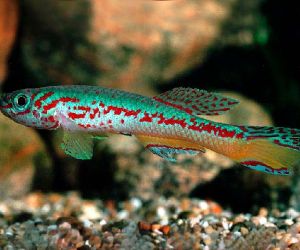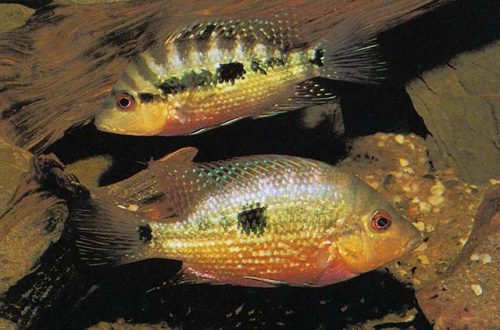
Analysis of Firefly
Rasbora Firefly, scientific name Boraras urophthalmoides, belongs to the Cyprinidae family. It belongs to one of the smallest aquarium fish, they are distinguished by bright coloring and high mobility. Unpretentious, easy to keep and breed, if you provide the proper conditions and choose the right neighbors.

Contents
Habitat
Wild representatives of the species are found on the territory of the modern states of Thailand, Cambodia and Vietnam. They live in small overgrown reservoirs with clean water such as swamps, floodplains, rice fields. During the rainy season, the range expands due to flooded coastal areas.
Brief information:
- The volume of the aquarium – from 40 liters.
- Temperature – 20-28°C
- Value pH — 6.0–7.0
- Water hardness – soft (1-10dGH)
- Substrate type – any
- Lighting – subdued
- Brackish water – no
- Water movement – minimum
- The size of the fish is about 2 cm.
- Food – any food
- Temperament – peaceful
- Keeping in a flock of 8-10 individuals
Description
A popular variety in the aquarium trade, the adult size is very small – only about 2 cm. They come from places very poor in nutrients, therefore, in the process of evolution, they underwent a process known as miniaturization, i.e. initially larger fish gradually, as a result of changing external conditions , decreased. It is worth noting that some varieties of this species have retained their size and sometimes reach 4 cm.
The color of the body is dominated by an orange / red tint. On the sides are two horizontal stripes of red and black, stretching from head to tail. At the base of the caudal fin there is a dark mark, which, combined with a stripe, resembles an exclamation point. Sexual dimorphism is weakly expressed.
Food
Accepts all types of dry, frozen and live foods of suitable size. It is recommended to serve different types of products, which has a beneficial effect on the overall tone of the fish. Feed 2-3 times a day in the amount eaten in 5 minutes.
Maintenance and care, arrangement of the aquarium
Despite the modest size of the Rasbora, the Firefly requires a tank of at least 40 liters, since during the mating season the dominant males form temporary territories that protect them from competitors. The design uses soft substrates, a large number of rooting and floating plants, snags, roots or tree branches are used as shelters.
Fish react badly to any, even a weak current, so when choosing a filter, be sure to consult a specialist and select the model that combines high performance, but at the same time causes excessive water movement. Other minimum required equipment consists of a heater, aerator and lighting system. Water conditions are characterized by slightly acidic pH values with low carbonate hardness. More about pH and dGH parameters in the section “Hydrochemical composition of water”.
Maintenance of the aquarium is reduced to the weekly replacement of part of the water (10-15% of the volume) with fresh, regular cleaning of the soil from glass waste from organic plaque.
Behavior and Compatibility
Peaceful schooling fish. Keeping in a flock of 8-10 individuals will allow Rasbora Firefly to feel safe, which will best affect their behavior and color. During the spawning period, males become territorial and attack any uninvited guest, however, such actions almost never lead to injury, it is rather an external demonstration of strength.
Due to their tiny size, they are only compatible with other dwarf species such as Rasbora Espes, Rasbora Harlequin, Rasbora Hengel, etc.
You should avoid sharing with larger relatives to avoid hybridization and keep your fish small.
Breeding / breeding
Refers to spawning species, females scatter eggs in thickets of plants, and males at this moment fertilize it. Parental instincts are poorly developed, immediately after spawning, the fish can eat their own caviar and fry that have appeared. Able to breed throughout the year without much attention from the aquarist, however, due to the above reasons, the survival rate will be at a very low level.
In order to increase the chances and protect juveniles from adult fish, it is recommended to breed in a separate tank – a spawning aquarium. The decoration is simple, the main attention is paid to the preservation of eggs, therefore, low-growing small-leaved plants or mosses such as Riccia floating and Javanese moss are used, which are planted on most of the surface of the substrate. Dense thickets of plants can provide reliable shelter for eggs no worse than special soil or nets.
The size of the spawning aquarium for this species is usually about 10 liters, half filled. The equipment used is an aerator, a heater and a simple sponge airlift filter of low power to prevent accidental suction of eggs and fry. Spawning occurs in dim light, so at first there is no need for a light source.
In order to somehow systematize the breeding process, experienced breeders use the method of adjusting the hydrochemical composition of water. In particular, the spawning stimulus is the inclusion of protein foods, i.e., meat, in the daily diet and the establishment of pH values at around 5.0–6.5 at dGH values of about 1–5°C and a temperature of 26–27°C. The beginning of the mating season will be marked by the fact that the females become noticeably rounder, and the males will choose a certain area of the aquarium for themselves and begin to actively show signs of attention to their chosen ones, inviting them to their place. At this point, you should prepare a separate tank and fill it with water from the general aquarium, then transplant several females and the most colorful males there, they should live in it for a couple of days. Spawning can be initiated by adding cool water, lowering the temperature by a few degrees. If you do this in the evening, then by morning it will be possible to get offspring. The easiest way to determine the end of spawning is by females – they will become noticeably slimmer.
The fish are returned. The fry will appear in 18 – 48 hours, and in another day they will begin to swim freely. Feed with specialized microscopic food for juvenile aquarium fish.
Fish diseases
A balanced diet and suitable living conditions are the best guarantee against the occurrence of diseases in freshwater fish, so if the first symptoms of an illness appear (discoloration, behavior), the first thing to do is check the condition and quality of the water, if necessary, return all values to normal, and only then do treatment. Read more about symptoms and treatments in the Aquarium Fish Diseases section.





